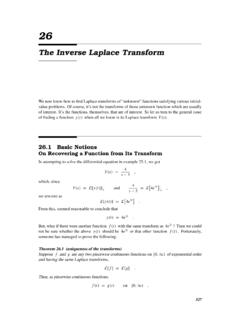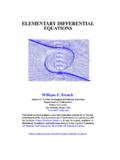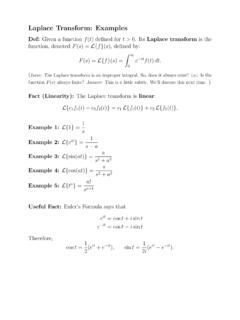Transcription of Laplace Transform Solution of Ordinary Differential Equations
1 LaplaceTransformSolutionOfODEs (c) 2006 Holbert Page 1 of 2 Laplace Transform Solution of Ordinary Differential Equations The Laplace Transform converts Differential Equations in the time domain to algebraic Equations in the frequency domain. There are three important steps to the process: (1) Transform ODE from the time domain to the frequency domain; (2) manipulate the algebraic Equations to form a Solution ; and (3) inverse Transform the Solution from the frequency to the time domain. Perhaps, the most common Laplace Transform pairs are those appearing in the table below: f(t) (t) u(t) tae t F(s) 1 s1 as+1 21s When applied to Differential Equations , Laplace transforms automatically account for initial conditions via )0()0()()()0()()(222yysssdttydxssdttxdLL = = YX (1) Inverse Laplace Transform Performing the inverse Transform is straightforward when using partial fractions expansion with the method of residues.
2 There are three possible cases: (1) simple roots (real and unequal), (2) simple complex roots, and (3) repeated roots (of the same value). 1. Simple roots The simple roots are placed in a partial fractions expansion ()( )()()()nnnmpsKpsKpsKpspspszszsKs++++++=+ ++++=KLL22112110)(F (2) The constants, Ki, can be found using the method of residues ipsiispsK =+=)()(F (3) Finally, the tabulated Laplace Transform pairs are used to invert the expression. This is a nice form since the Solution is tpntptpneKeKeKtf +++=L2121)( (4) 2.
3 Complex conjugate roots Complex roots result in a Laplace Transform of the form LL+++ + + =++++ +=)()()()()(11*11 jsKjsKjsKjsKsF (5) LaplaceTransformSolutionOfODEs (c) 2006 Holbert Page 2 of 2 The K1 can then be found using the same method as for simple roots; however, the positive root of the form j+ must be the one used to find K1, that is jssjsK+ = +=)()(1F (6) The corresponding time domain function is then ()L++= teKtftcos2)(1 (7) 3.
4 Repeated roots When F(s) has a root of multiplicity r, then F(s) is written as ()()()LL+++++++=+=rrrpsKpsKpsKpssss11211 2111111)()()(QPF (8) where the time domain function is then ()LL+ +++= tprrtptpertKetKeKtf111!1)(111211 (9) That is, we obtain the exponentials multiplied by t s, where the K1j terms are evaluated from ()()[]1)(!111psrjrjrjspsdsdjrK = + =F (10) This actually simplifies nicely until you reach s3 terms, that is, for a double root 21)(ps ()()[]11)()(21112112pspsspsdsdKspsK = =+=+=FF (11) Thus K12 is found just like for simple roots.
5 Note this backward order of solving for the K s, that is, we solve for the K s of the higher order terms first. Initial-Value and Final-Value Theorems Sometimes, the initial and final value theorems provide a quick manner in which to partial check one s overall answer. The initial value theorem states )(lim)(lims s tf s0tF = (12) Almost inevitably, we must use L'Hopital s Rule, which states that if g(x)/h(x) has the indeterminate form 0/0 or / at x = c, then )(')('lim)()(limxhxg xhxg cxcx = (13) The final value theorem is )(lim)(lims s tf 0stF = (14)









